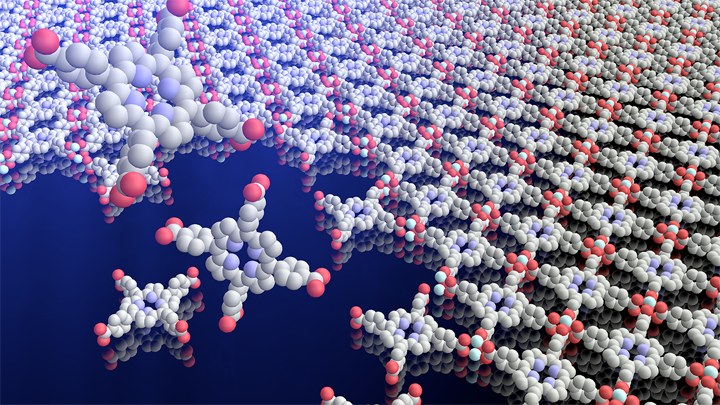(Light-based ‘tractor beam’ assembles materials at the nanoscale)
2019/11/4 アメリカ合衆国・ワシントン大学(UW)

・ UW が、バイオロジー分野で幅広く利用される光トラップ(optical traps)や光ピンセット(optical tweezers)として知られる光の技術を利用した、ナノスケール構造体の新しい作製方法を開発。
・ 光によりナノスケールで 2 個の構成要素をハンダ付けすることから、「photonic nanosoldering」とする同技術では、SF の「トラクター・ビーム」のような働きでナノスケールの半導体材料を捕捉し、より大きな構造体を精確に構築。水の代わりにカーボンリッチな有機溶媒を使用するため、新しいアプリケーションの可能性が期待できる。
・ 同技術プロセスでは、溶媒に浮遊するコンポーネントのサイズ・形状をナノスケールで制御して構造体をパーツ毎に組み立てる。チャンバー面等も無いため、歪みや欠陥が最小限に抑えられる。
・ 有機溶媒を使用することで、水や空気で劣化・腐食するコンポーネントの取り扱いが可能となり、さらに材料の過熱を助けて材料の変換や化学反応を促進する。
・ ヘテロ構造のナノワイヤを構築して同技術を実証。ビスマスのキャップを付けたゲルマニウムの短いナノロッド(長さ数百 nm、直径数十 nm)を、光の「トラクター・ビーム」で捉えると、ビームのエネルギーが同時にナノロッドを過熱してビスマスのキャップが溶解。次のナノロッドをビームに誘導すると、溶けたキャップで 2 本のナノロッドが繋がる。
・ このプロセスを繰り返し、半導体-金属の接合パターンのヘテロ構造ナノワイヤを作製(元の長さの5~10 倍)。今回合成したゲルマニウム-ビスマスのような接合部をもつナノワイヤは、将来的に量子コンピューティングのトポロジカル q ビット開発の可能性を提供する。
・ 同技術の「トラクター・ビーム」は、実質的には光トラップを生成する高度に集束したレーザー。光トラップ手法は、1970 年代に Arthur Ashkin 氏が開発しノーベル賞を受賞している。水中や真空の環境での利用に限られていたが、本研究では有機溶媒のような揮発的な環境での光トラップを実現した。
・ 光ピンセットでは、レーザービームを構成するフォトンが光ピンセットの近傍で発する力でオブジェクトを捕捉する。レーザー特性の調整で、1 本のナノロッドや長いナノワイヤ等のあらゆるオブジェクトを捕捉・解放できる。
・ 同技術は、様々なアプリケーションに向けた、異種の材料から成るナノスケール構造の積層造形を可能にするものと考える。
・ 本研究には、米国立科学財団(NSF)、UW Molecular Engineering Materials Center、UW Molecular Engineering & Sciences Institutes、UW Institute for Nano-engineered Systems、UW Clean Energy Institute、ワシントン州、Washington Research Foundation、および米軍科学研究局(AFOSR.)が資金を提供した。
URL: https://www.washington.edu/news/2019/11/04/light-based-tractor-beam/
(関連情報)
Nature Communications 掲載論文(フルテキスト)
Optically oriented attachment of nanoscale metal-semiconductor heterostructures in organic solvents via photonic nanosoldering
URL: https://www.nature.com/articles/s41467-019-12827-w
<NEDO海外技術情報より>
Abstract
As devices approach the single-nanoparticle scale, the rational assembly of nanomaterial heterojunctions remains a persistent challenge. While optical traps can manipulate objects in three dimensions, to date, nanoscale materials have been trapped primarily in aqueous solvents or vacuum. Here, we demonstrate the use of optical traps to manipulate, align, and assemble metal-seeded nanowire building blocks in a range of organic solvents. Anisotropic radiation pressure generates an optical torque that orients each nanowire, and subsequent trapping of aligned nanowires enables deterministic fabrication of arbitrarily long heterostructures of periodically repeating bismuth-nanocrystal/germanium-nanowire junctions. Heat transport calculations, back-focal-plane interferometry, and optical images reveal that the bismuth nanocrystal melts during trapping, facilitating tip-to-tail “nanosoldering” of the germanium nanowires. These bismuth-semiconductor interfaces may be useful for quantum computing or thermoelectric applications. In addition, the ability to trap nanostructures in oxygen- and water-free organic media broadly expands the library of materials available for optical manipulation and single-particle spectroscopy.



